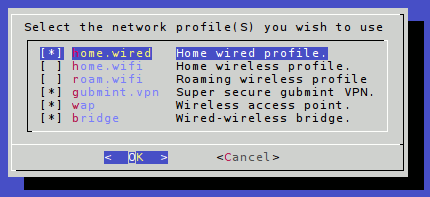System Scripts
About
All scripts that are somehow system-related.
If there is no description for a script below, check the script itself for comments.
Rsync-based Bash Backup Function
backup_function.sh contains a
function named backup that you can use in your backup
scripts. It will maintain a working copy of a directory at another
location and it will also create snapshot archives of modifed and
deleted files so that you can retrieve old data if necessary.
See the comments in the file for usage information along with an example of how to purge snapshot archives older than a month.
fstab-uuid
fstab-uuid parses fstab and crypttab files,
replaces device paths with UUIDs, and prints the entries to
STDOUT. It is meant as a helper script for migrating from
paths to UUIDs. It should not be used to automatically replace
these files.
It also includes a scan mode for non-fstab formulate files. In this mode it will parse a file line-by-line and print out any lines that contain paths that could be replaced by UUIDs (along with the matching UUIDs). The matching is naïve and again only meant as an aid for manually editing the file.
Subnet Launcher Function
launch_subnet.sh contains a function
named launch_subnet that will automate several aspect of
subnet management such as opening the required ports and starting the
DHCP server. The file should be sourced from another bash script that
sets the required variables before calling the function.
The file also contains a function named
print_launch_subnet_usage that will list and describe the
variables expected by the launch_subnet function.
For more information read my notes about configuring a subnet with DHCP and DNS. There you will also find example scripts and configuration files for
- dhcpd
- named
- hostapd
Edit (2017-11-01)
I ended up rewriting the script to make it more versatile (e.g. bridging nats on the local subnet to support VMs and tethered devices with USB interfaces). I will put it back up on the site shortly along with some other ad-hoc networking tools as soon as I have time to organize them and write a decent README. Feel free to email me a reminder if I take too long.
List Apps by MIME-type
list_apps_by_mimetype.py is a Python script that uses the Mimeo module to… *drumroll* list applications by MIME-type. It was written as a quick example in response to a question on the forum.
merge-passwd
Interactively merge serveral passwd-like files (e.g. /etc/passwd, /etc/group). This is mainly intended for merging .pacnew files but should be useful in other cases.
Help Message
usage: merge-passwd [-h] [-o <path>] [-c] [-g] <path> [<path> ...]
Merge changes in password files.
positional arguments:
<path> The files to merge. Multiple may be given. If only one
is given, a matching .pacnew file must exist.
optional arguments:
-h, --help show this help message and exit
-o <path>, --output <path>
The output file. This may be one of the input files,
but it is recommended to use a different file and
check the output before overwriting system files.
-c, --confirm Confirm before writing output file.
-g, --group Treat files as group files.netctl-checklist
A simple dialogue that lets you simultaneously enable or disable multiple networks via netctl.
Screenshot

timestats
timestats a command multiple times and calculates simple runtime statistics. The results can be plotted in a violin plot.
Dependencies
- python3
- python-numpy
- python-matplotlib (optional, for plotting)
Help Message
usage: timestats [-h] [-r RUNS] [-p] <cmd|arg> [<cmd|arg> ...]
Run a command multiple times and print some basic statistics about the
runtimes.
positional arguments:
<cmd|arg> The command and arguments to run.
optional arguments:
-h, --help show this help message and exit
-r RUNS, --runs RUNS The number of times to run the command. Default: 10
-p, --plot Plot the results.
Hint: use "--" to force all following arguments to be interpretted as the
command and arguments to run.Urxvt Quake-like Terminal
urxvtq creates a quake-like togglable urxvt
terminal. The script only requires xdotool and urxvtdc. By default the
terminal uses tabs. To remove these, simply remove
-pe 'default,tabbed`` from theurxvtdc` command.
urxvtdc is a simple convenience script that will start up the urxvt daemon if necessary when invoking a client.
xrandroutputchangewait
Yeah, the name’s ugly, but hey, it’s descriptive.
xrandroutputchangewait is a minimalist command-line utility for use in other scripts. When run, it will wait for Xrandr output changes and then exit. You can use it in scripts to automatically configure displays and other things when monitors are connected or disconnected.
Compilation
gcc -Wall -lX11 -lXrandr -o xrandr-outputchangewait{,.c}Example 1
Run commands when an HDMI monitor is connected or disconnected:
#!/bin/bash
# Change this to the appropriate path on your system.
STATUSPATH_='/sys/devices/pci0000:00/0000:00:02.0/drm/card0/card0-HDMI-A-1/status'
while xrandroutputchangewait
do
content_="$(< "$STATUSPATH_")"
case "$content_" in
connected)
# Run xrandr or whatever here.
;;
disconnected)
# Run xrandr or whatever here.
;;
*)
echo 'error: unexpected status' >&2
;;
esac
doneExample 2
Run specific commands for different HDMI monitors based on their
unique EDIDs. This is useful if, for example, you have a laptop that
connects to different monitors at home and at work. One way would be to
configure each setup and then get the exact command using
unxrandr (included in the arandr package).
edidchecksum_="$(sha256sum '/sys/devices/pci0000:00/0000:00:02.0/drm/card0/card0-HDMI-A-1/edid')"
edidchecksum_="${edidchecksum_%% *}"
case "$edidchecksum_" in
aba161abb9e52b1dcc4c66b367356d66a87610fa49764b72a97ddb0f9be10733)
# Do stuff here if monitor A is connected.
# xrandr --output HDMI1 --pos 0x0 ...
;;
ed329858041295cbf1aca3be39874df75551f0ad1f52568550fbbff542282d13)
# Do other stuff here if monitor B is connected.
# xrandr --output HDMI1 --pos 1650x0 ...
;;
...
esac- Contact
- echo xyne.archlinux.org | sed 's/\./@/'
- Validation
- XHTML 1.0 Strict CSS level 3 Atom 1.0
